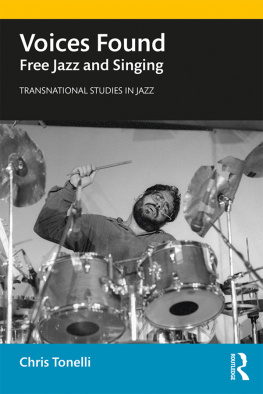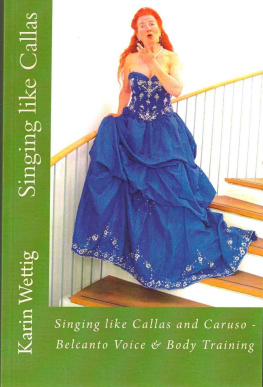HEAD FIRST
The Language of the Head Voice:
A Concise Study of Learning to Sing
in the Head Voice
Denes Striny
Foreword by Birgit Nilsson

Copyright 2007 by
Hamilton Books
4501 Forbes Boulevard
Suite 200
Lanham, Maryland 20706
Hamilton Books Acquisitions Department (301) 459-3366
Estover Road
Plymouth PL6 7PY
United Kingdom
All rights reserved
Printed in the United States of America
British Library Cataloging in Publication Information Available
Library of Congress Control Number: 2006939831
ISBN-13: 978-0-7618-3671-1 (paperback : alk. paper)
ISBN-10: 0-7618-3671-3 (paperback : alk. paper)
 The paper used in this publication meets the minimum
The paper used in this publication meets the minimum
requirements of American National Standard for Information
SciencesPermanence of Paper for Printed Library Materials,
ANSI Z39.481984
Dedication
In Remembrance
On the morning of January 6th at my apartment in New York City, I had just finished a phone conversation with my editor Bruce Burch about my book Head First: The Language of the Head Voice. We both felt the book was nearing completion as we discussed the front and back cover. I had received, four days earlier, the finished digital picture that I wanted for the front cover. I had found that picture at the Metropolitan Opera Guild Office who gave permission for its use and formatted the picture for the dimensions of the revised book. The picture was that of Birgit Nilsson and Franco Corelli in a 1967 production of Turandot, a performance I attended while still in college. She had on that incredible head dress; the picture had it all.
I remember my first image of Birgit Nilsson while in high school from an old Ed Sullivan Show. She sang In questa reggia from Act II of Turandot. I had never heard an opera at this time and sat before the old black and white TV set stunned by the sound that she made with her voiceit was huge, exciting, beautiful, and bewildering. How did she do this? She was wearing a white, maybe taffeta dress, tightly fitted, and was standing in front of a trellis filled with roses. If there were any tension in her body one certainly would have seen it; but there was none. I didnt know anything about what I had just seen, but at that moment I knew I wanted to be a part of it. I followed Birgits performances from the 60s to the end of her career.
In 1987, after a 17 performance run of Die Meistersinger von Nrnberg in Great Britain, singing my first Wagnerian roleWaltherI received a phone call from my best friend Michael Cordovana at The Catholic University of America in Washington, DC. Mike asked me if I would like to sing for Birgit Nilsson; he was bringing her to the university for a Master Class. I, of course, said yes, it was a chance to meet and sing for the woman who had such a profound influence on me.
A month later I was in DC and had my first private lesson with her. There was another bond I had with Birgit. Only three weeks earlier I discovered through Catholic Charities in St. Paul, Minnesota (Im an adopted kid) that my heritage was not German/Austrian, as I for many years had been told, but Swedishon both sides. So when I met the great Birgit Nilsson for the first time, I felt that we had known each other forever. She responded quite personably. We laughed, joked, and kidded with each other and made some wonderful music for three days during that Master Class. She invited me to come to Buckaburg, Germany, that October where she was giving a month-long series of classes. I worked with her again privately and within the classesoften six hours a day, six days a week. Wed have breakfast together each morning and many times dinner; she wanted to teach me how to be Swedish, although she would tell me she thought there was a touch of Finnish in me, also.
This time with her was like a dream. We would work on German together in the evenings until she told me that I finally was speaking Hoch Deutsch. The main point that characterized our sessions was laughter, jokes, and mutual respect. We both had a tremendous respect for each other. Her knowledge and insight were unparalleled.
One morning after singing at a party given by the Count at the castle where we were staying (along with 600 of his closest friends), I arrived at breakfast to work with Birgit as usual, but she said frantically to me, You do not have time to have breakfast; you have a lot of driving to do to get to Bayreuth by tomorrow morning. I spoke to Wieland last night and he wants to hear you tomorrow! She had personally arranged for a private audition at the Festspiele Haus with one of the great Wagnerian directors.
I was thrilled; I was ecstatic; this really was a dream! Walking into the Festspiele Haus, I was told to report to the Bursars Office to get my check; I had no idea what they were talking about and only later understood they were paying me to sing an audition. I was still awe-struck as I stood center stage with the set of Siegfried behind me, one light shining down front center with only Wolfgang Wagner as the audience in the auditorium. He wanted to hear the complete role of Siegmund from Die Walkre. What fun! What excitement! That was a moment Ill never forget. I owe that experience and many more to Birgit Nilsson.
For the next two years I worked with Birgit whenever she came to New York City; she would always give me a call when she came into town. I remember one call from her in 1993. She was coming to town to do a Master Class and also to participate in a 350th celebration of the Swedes landing in America. She asked if I would drive her down to the festivitiesa big dinner with the King and Queen of Sweden at the Hotel Dupont in Wilmington, Delaware, and be her escort for the event.
We drove down; as Birgit would say, What a hoot! At 1 oclock in the morning we left to return to New York City, laughing and talking non-stop. Suddenly I noticed we were surrounded by cornfields and complete darkness; I had confused the Jersey Turnpike with Interstate 95, and we were quite lost. There were no gas stations, no houses, and no lights. I couldnt believe itlost in a cornfield with Birgit Nilsson! We had to drive around quite awhile before finding someone who could get us back on the path to New York City. We didnt really mind; we were able to enjoy the dilemma together, and it deepened our friendship and respect.
In 2001 I founded and was the Artistic Director for Shaker Mountain Opera at the Koussevitsky Arts Center in Pittsfield, Massachusetts. Birgit consented to be the Honorary Chair of the Festival. We opened with an amazing performance of Die Walkre which I conducted with the Albany Symphony Orchestra. The following year we went on to perform Gtterdmmerung. All of this was inspired by this amazing friend and incredible force of nature. Id send her tapes of all the performances and would always receive a very gracious response with a critique.
I hadnt intended these personal stories to appear in this book, but on that morning of January 6, 2006, something else happened. I heard that Birgit Nilsson had died. It is very hard to envision a world without Birgit. Her friendship gave me the strength to realize whatever potential exists in me. The battles she had with her voice as a beginning singer and with her early career showed me what kind of person it takes to accomplish this thing called music on a high level. I will always remember Birgit and will always be deeply indebted to her.













 The paper used in this publication meets the minimum
The paper used in this publication meets the minimum